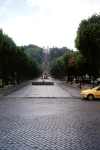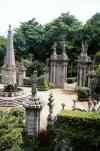|
|
|
Vila Real (Royal City) is a lively city located in the Tras-os-Montes area of Portugal. Through the city runs a very deep gorge of the Congo River. The Tras-os-Montes area is rough country with mountains and deep ravines. As a result there are some amazing vistas as you drive from area to area. Vila Real has a youthful spirit about it, probably as a result of the university. In spite of this youthfulness, there is a rich historical and architectual heritage within and nearby the city.
|
|

Click to enlarge |
This is the view of the front door of the Vila Real Chapel. Pictured are Elders Edge and Escobar, Irmã Maria, and Sister West.
|
|
|
This is a picture of all the members attending the district conference of the Vila Real District in the Fall of 1998. We had a visiting Area Authority Seventy, Elder Castilani, from Italy in attendance. Also attending was the second counselor in the mission presidency, President Belmiro and his wife. There also some visitors from Porto.
|

Click to enlarge |
|

Click to enlarge |
This is the classical view of the Solar de Mateus that is displayed in most tour books about this area. The only icon that is discretely covered by the West family, is the statue of a nude woman reclining in the reflecting pond. During the summer months, this country manor is host for a number of artistic and musical conferences.
|
|
|
The Solar de Mateus dates from the first half of the 18th century. It was designed by Nicolau Nasoni and is a perfect example of Portuguese baroque architecture. The house itself is beautiful. The gardens and reflecting pools create a cool atmosphere on hot summer afternoons.
|

Click to enlarge |
|

Click to enlarge |
The gardens around the Solar de Mateus are gorgeous. They are a great example of typical formal gardens in Portugal.
|
|
|
Lamego is located south of Vila Real and across the Douro river. The trip from Vila Real takes the traveler down steep canyons to the river and then back up the gorges to Lamego. Lamego is an old city. The first national assembly of representatives of the nobles, the clergy, and the towns recognizing Alfonso Henriques as the first king of Portugal was held in Lamego in 1143. The central praça in Lamego leads the eye to the Santuário de Nossa Senhora dos Remédios. There is a path leading from the praça to the church that is similar to the one at Bom Jesus in Braga.
|

Click to enlarge |
|

Click to enlarge |
From the Lamego´s praça there is a concourse of ramps, stairs, and gardens that lead to the Santuary. From the bottom a ramp will ascend a short distance where you will encounter gardens, statues, and pools. The vista in this picture is just below the Church itself. There are large pylons and statures interspersed with vegetation. This was one of the most delightful and restful locations I visited in Portugal.
|
|
|
The 18th century façade of the Church is of stucco which serves to highlight the elegant granite. Notice on the stairs leading from this level the upper level are decorated with beautiful azulejos.
|

Click to enlarge |
|

Click to enlarge |
Located a short distance from Lamego is the little rustic church at São
Pedro de Balsemão, claimed to be the oldest in Christian church in Portugal. Built in the 7th century by the Christian Visigoths before the arrival of the Moors, it was only restored in the 17th century. Picture is of and curtesy of Jake Walkenhorst.
|
|

